Church Wilne WTW (2020)
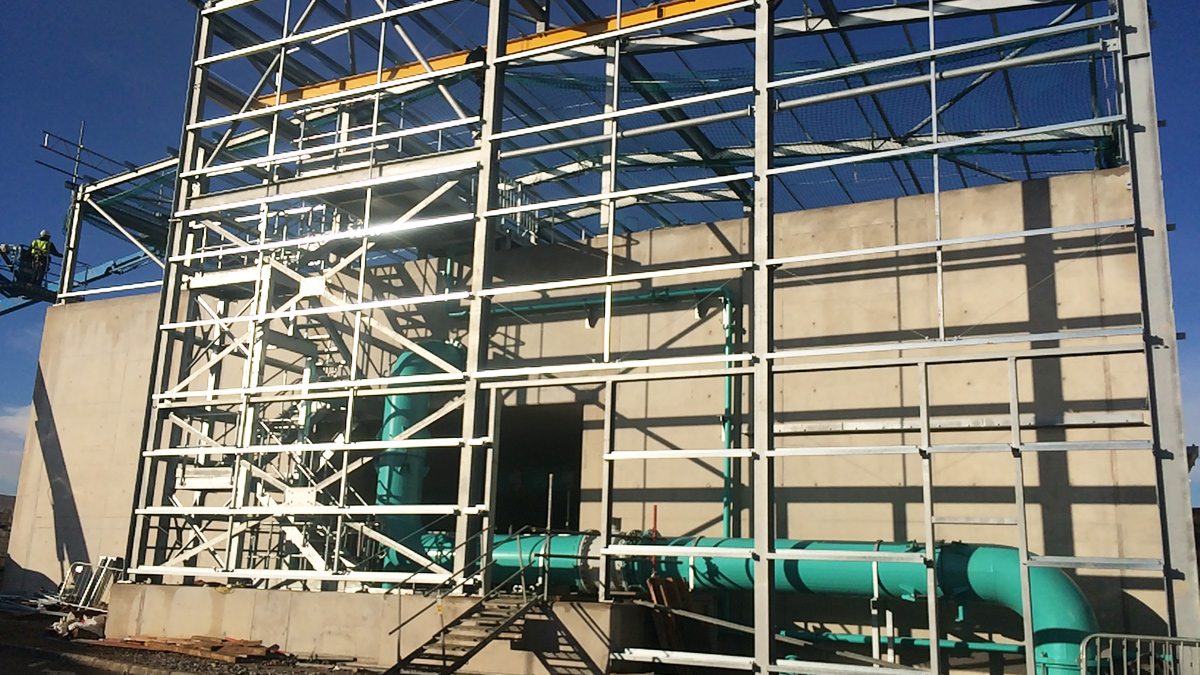
GAC under construction - Courtesy of MWHT
Situated on the Derbyshire/Nottinghamshire border, Church Wilne WTW serves 600,000 Severn Trent (ST) customers in the East Midlands. Built in 1967 to extract and treat 27 ML/day from the River Derwent, the works has been extended twice to 135 ML/day meeting the needs of both a growing population and increased water quality standards. However, the works has been temporarily reduced in capacity to 105 ML/d due to a reduction in granular activated carbon (GAC) capacity caused by the poor condition of the existing GAC vessels. This £7m project provides a new GAC facility to remove pesticides, taste, odour and increase throughput by 30 ML/day to 135 ML/day deployable output. In September 2018, Severn Trent Resources requested the MWH Treatment team prioritise commissioning of half the plant three months early (by the end of May 2019) to assist in the delivery of the Birmingham Resilience Scheme and provide resilience against 2019 summer demands following a dry winter.
Design engagement
To create a vision of how best to deliver this increased GAC and backwash facility, a Visual Project Initiation session was held; a collaborative planning session in which an evaluation of multiple options ensured the most effective and best value solution was chosen. The team harnessed internal support to implement a new style of delivery, overcoming conventional construction mindsets, as well as using new design and collaboration software and digital planning tools. The specific involvement of the supply chain in the collaborative approach at the earliest stages enabled the contribution of their specific ideas, which are not normally available until outline contracting later in the process.
Design concept development
The solution chosen was derived following assessment of several options; pressure vessels vs open beds, in situ construction vs precast. The chosen TOTEX efficient solution that would achieve the key time parameters was to construct the GAC contactors as four open beds with a working capacity of 80 MLD, and the backwash tank of two cells each 200m3 volume. The key to this project delivery was the pace required to effectively achieve the deployable output date.
The use of digital tools has been key in achieving progress pace. The site was digitally mapped, with federated models developed using the Autodesk BIM suite of tools. By developing a 3D model, this solution was transformed into a concept that was further developed, using 4D planning and scheduling software, to define the delivery strategy and construction sequencing.
Planning on the project has been managed through rigorous deployment of lean production control processes. Starting with the high level Primavera (P6) Programme with key milestones clearly identified, a detailed rolling four-week ‘look ahead’ plan was developed. From this, a weekly plan was reviewed daily by all stakeholders to monitor progress. If tasks were not completed within the realistic agreed timescale, root cause analysis established the reason before the activity was re-scheduled. This way, a constant learning and improvement process was developed which in turn influenced the future planning of tasks. Rigorous focus also allowed for benefits to be protected and project certainty achieved.
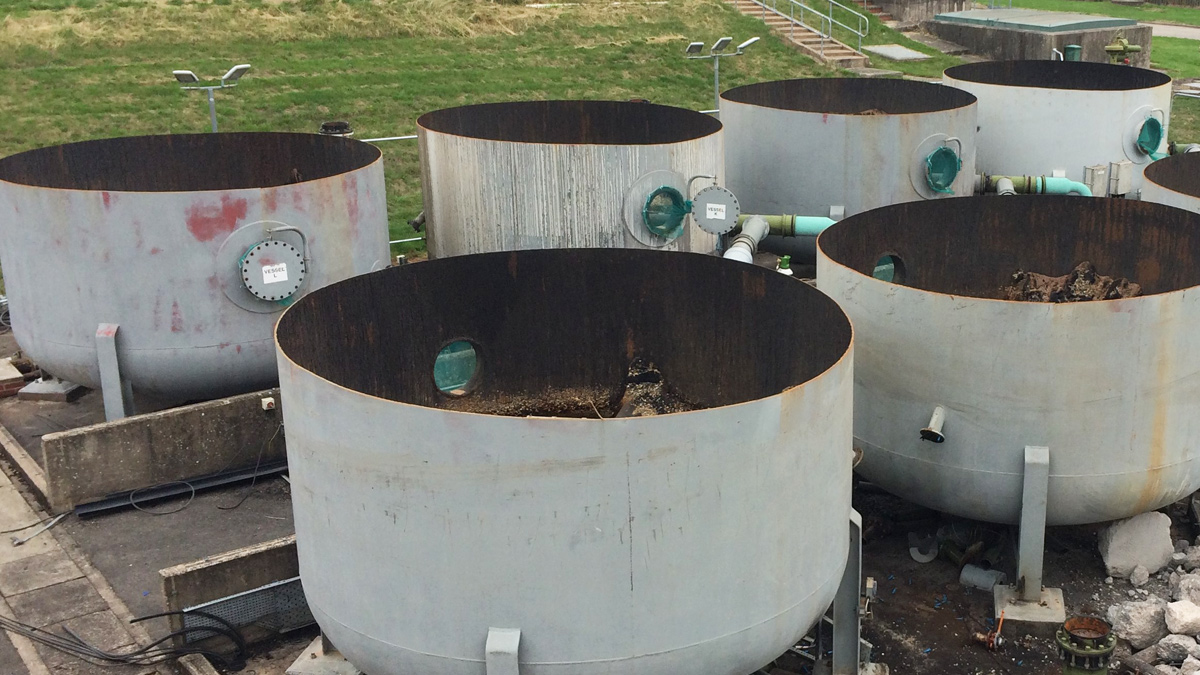
Existing GAC steel tanks which needed to be removed – Courtesy of MWHT
Project challenges
The project addressed a number of unique or complex issues on the site that the team worked collaboratively to overcome:
Removal of redundant structures: Construction of the new GAC structure and backwash tank required removal of 12 (No.) 4m diameter 8m high GAC steel tanks and the reinforced concrete Kalic building.
The steel GAC tanks had an internal bitumen coating which required specialist high pressure water steel cutting technology. Additionally, lifting arrangements for removal of the sections required studious temporary works design and high levels of supervision in place for risk and contingency plans agreed due to the proximity of live existing 800mm diameter GRP services to the contact tank.
Power diversion: The new building was directly online with major power feed cables to the existing GAC building which required to be diverted through a complex arrangement of existing services and a major shutdown of the existing GAC plant to install and terminate cables.
Airport restrictions: The site is located near to a radar scanner for the East Midlands airport. The working area for the GAC building was reduced by a third for crawler cranes, to prevent the jib interfering with line of sight of radar.
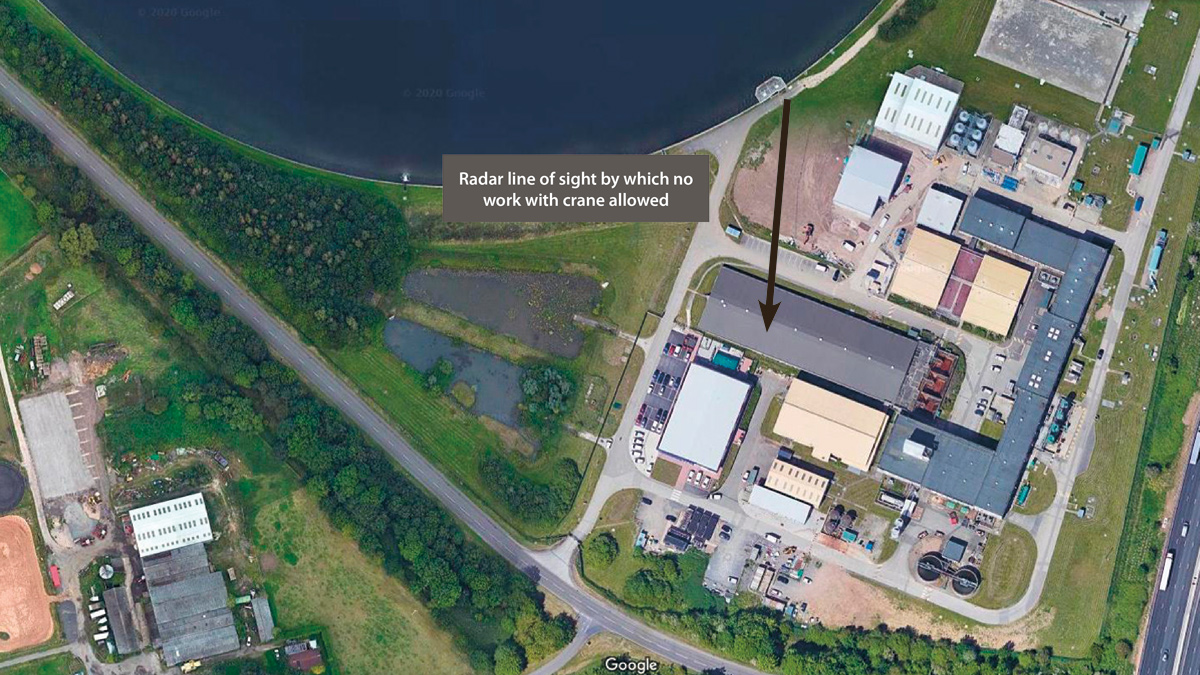
Google maps: Restricted working area – Courtesy of MWHT
Existing pipework: Early understanding of the final GAC outlet and inlet tie ins regarding existing 800mm and 1200mm live GRP mains was vital. However, it was soon discovered that both existing mains included mass concrete thrust blocks where the tie ins were to take place. From the very start of the project, discussions took place as to what risk and contingency plans would be required, and a provisional two-week reduced flow through works date was penciled some 12 months in advance of when tie in was to take place.
Major temporary work: Due to the lack of working space available to build the new GAC structure, major temporary works design was required to be undertaken to sheet pile the 4m deep excavations whilst still allowing access for the 80 tonne crawler crane and allow spoil to be kept within the working area. In conjunction with the geotechnical membrane supplier, the temporary crane mat was reduced from 1200mm thick to 800m thick type 1.
Programme challenge: The original programme included a start date on site of 6 June 2018 with water into service 24 June 2019. ST requested that the water into service for a minimum two cells was brought forward to 29 April 2019 to reduce expected water grid risks associated with major work on the Birmingham Resilience projects in summer 2019. This programme was achieved through collaborative working to develop innovative approaches which delivered the fast track solution.
Innovative working
The existing works included a four bed GAC. The local production reported it as being a well-designed, easily operated installation and so was used as the basis of design for the new building. A HAZCON was undertaken with 3D modelling, augmented and virtual reality technology, wherein the designers, site construction team, all major sub-contractors, and the client developed a view of the most effective approach for both construction, and future operation and maintenance of the plant. Solutions proposed in the HAZCON enabled an 8-week reduction from the original programme using innovative design and construction techniques as follows:
Gallery design: The team designed a non-standard approach to the gallery works, utilising on site precasting to help develop a system that allowed multi trade access to levels within the gallery earlier than would normally be planned.
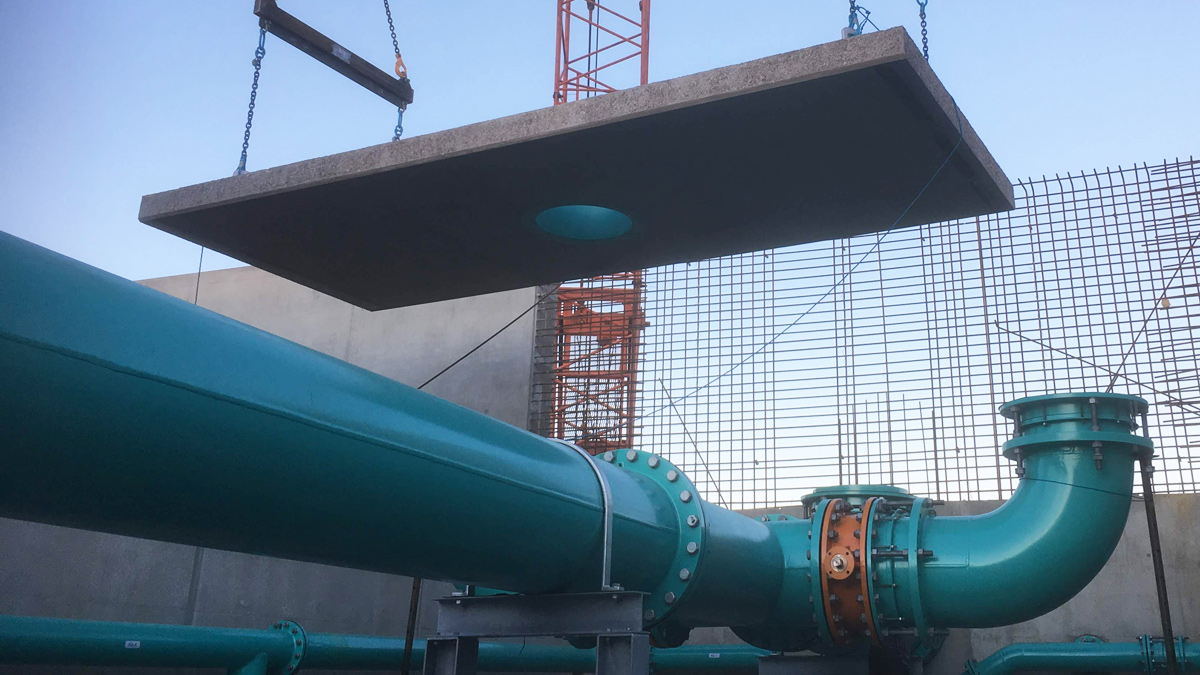
Precast panel construction – Courtesy of MWHT
Using onsite-cast precast panels above the main pipe gallery as permanent shutters for the high-level inlet channel, allowed the large 500/1000mm diameter steel process pipework to be installed via crane rather than having to be slid in as was the case on old GAC buildings. Additionally, by rescheduling the sequence of wall pours and with very detailed collaborative planning, the major mechanical installation proceeded whilst the external walls were still constructed without any safety issues.
The mezzanine access walkway steelwork was designed to act as support for large process pipes and was subsequently tied in with the main structural steel portal frame.
The two main sections of mezzanine floor were brought to site and erected on the ground in sections before being installed in larger units using the mobile crane, thereby improving safety and reducing interfaces. Further, the second height mezzanine floor was designed to enable pipework positioned under the flooring to be attached to the structure before being lifted into place.
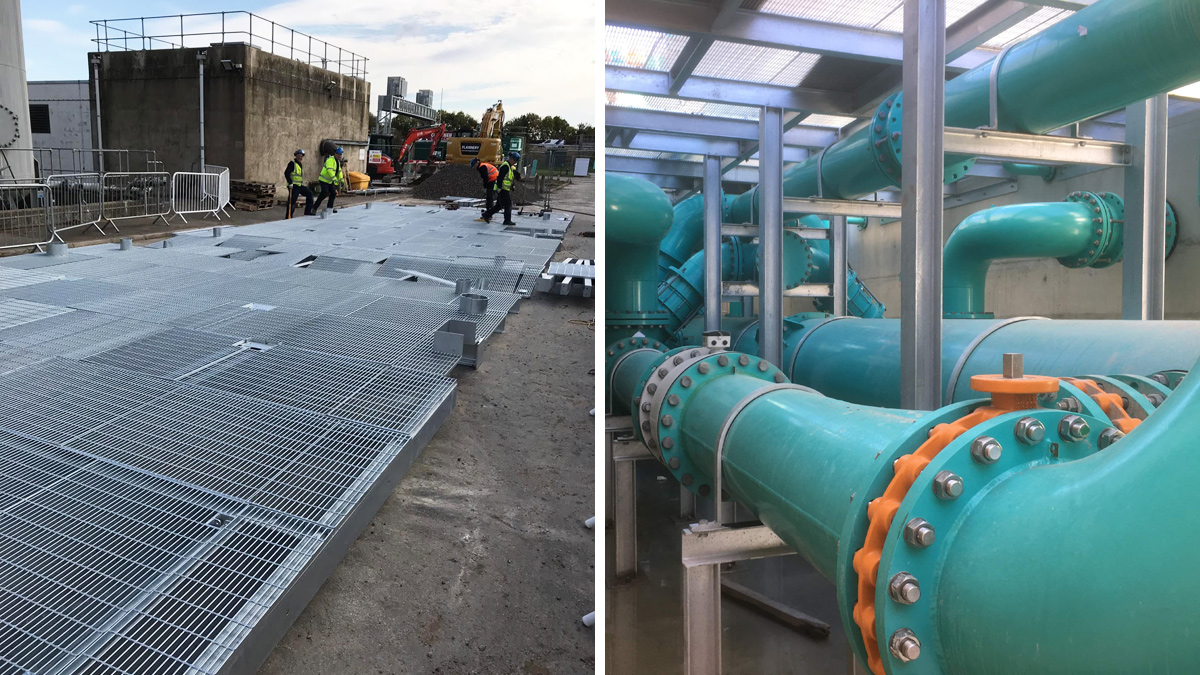
Mezzanine floor (left) preassembly and (right) pipe support – Courtesy of MWHT
Effective use of building space: Dead space within the new structure was utilised to develop a separate control room, reducing the build.
Multipurpose low-level access ways: Incorporated within each of the GAC tanks and located just above nozzle bed level which ensured:
- No high-level scaffold access required during construction of dwarf walls and nozzle slab.
- Earlier installation of the steel portal frame and cladding as the nozzle slab could be accessed pumping concrete through the accessways. This allowed construction in winter with an environment easier to produce the high-quality finish required.
- Severn Trent had a simple and effective access arrangement for future maintenance of the Cadar Ltd nozzles or the media replacement.
Portal frame: The steel portal frame incorporated a number of specific activities that improved programme delivery:
- A special galvanised shim technique was used which negated the need for post construction grouting; saving time and avoiding the safety risk of working from MEWPS to undertake the grouting before cladding.
- The overhead beam arrangement design allowed the electrical hoist supplier to install the catenary and motorised hoist on the ground at safe level before being fixed to the portal frame with only the final connection of the cabling to complete.
- Cladding sequencing was organised to enable access for electrical and mechanical small-bore trades to commence their works whilst the remaining cladding side panels were completed.
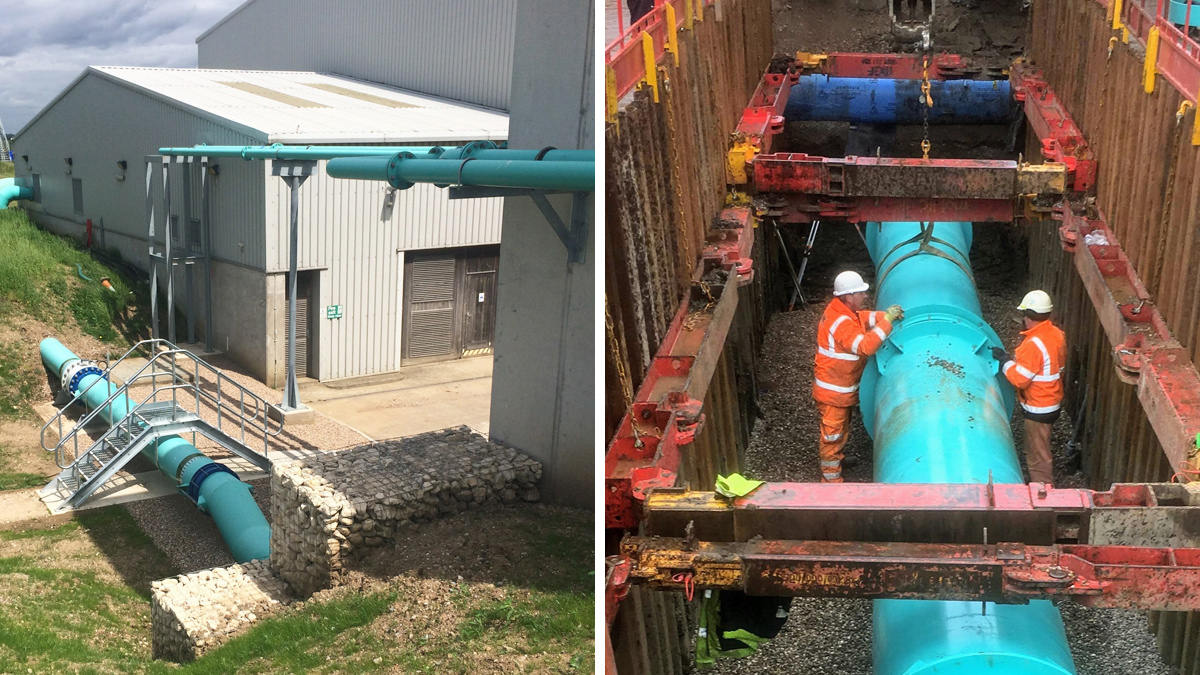
(left) Low level access ways and (right) deep outlet pipework – Courtesy of MWHT
External pipework
- The main 800mm. diameter inlet and 1000mm. diameter outlet pipework required 5m deep excavations between the new and the existing GAC buildings. The work could not be started until all the cladding was installed and required precision accuracy online and level to enable final large diameter carbon steel fabrications to take place over a short turnover time of 2-3 days.
- Existing GRP pipework had approximately 20m3 concrete surrounds at the necessary connection points. To avoid any issues with damaging these relatively fragile pipes, 24-hour hydro water demolition was undertaken over a three-day period. Once completed, new pipework and valves were installed and thrust blocks reinstated.
Church Wilne WTW GAC Pant: Supply chain – key participants
- Client: Severn Trent
- Designer and main contractor: MWH Treatment
- Ground investigation works: Socotec UK Ltd
- Demolition: Derby Demolition Ltd
- Concrete piling: Aarsleff Ground Engineering
- Electrical cabling/mains cable diversion: Elsym Installations Ltd
- Pumps: SPP Pumps Ltd
- Diamond cutting: Access Drilling Services Ltd
- FRC package: North East Reinforcement Ltd
- Pipework: Fluid Sealing & Engineering Ltd
- Earthworks package: Hollywood Civil Engineering Ltd
- MWCS package: WABGS Ltd
- Access steelwork: Galliford Try Fabrications
- GAC building (steelwork and cladding): Robinson Structures Ltd
- Panel and software modification: Boulting Ltd
- Electrical cabling: Southern & Redfern Industrial Solutions Ltd
- VSDs: Total Automation & Power
- Air scour headers: Alpha Plus Ltd
- Cadar floor installation: Filtec Water Services Ltd
- Security doors: Liddle Doors Ltd
- Scaffolding: High Peak Scaffolding Ltd
- Shoring/temporary works: National Trench Safety UK
- GAC media: Chemviron Carbon Ltd
- GAC overhead crane: T Allen Engineering Services Ltd
- Valve modifications: Glenfield Invicta
- Civil pipework installation: McAndrew Utilities & Civil Engineering Contractors Ltd
- GAC ventilation: Air Technology Systems Ltd
- Hydro demolition: Buxton Water Ltd
- Lagging: Jade Insulation Ltd
- Steel walkovers: Tushingham Steel Fabricators Ltd
- Road surfacing (Tarmac): Martin Cowman Ltd
- Concrete: Tarmac
- Rebar: Hy-ten Ltd
- Stone: Johnsons Aggregates
- Air flow meters: Endress and Hauser Ltd
- Flow meter/level instruments: Pulsar Process Management Ltd
- Sump pump: Grundfos Pumps Ltd
- Penstocks: Ham Baker Group
- Level probes: Hawker Electronics Ltd
- Pipes and fittings: UTS Ltd
- DI Pipework: Saint Gobain PAM UK
- Safety showers & eyebaths: Aqua Safety Showers International Ltd
Successes
The team rose to this challenge, through detailed collaborative planning to re-sequence programme activities. A second challenge was then presented to the team for a further best endeavours improvement and, through the hard work and collaborative effort, the plant went live on 29 April 2019. Severn Trent recognised this huge effort with a team award in the ‘Project Team of the Year’ category in their business-wide Awesome Awards 2019.













